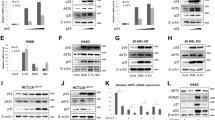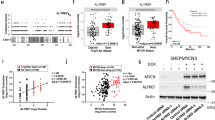Abstract
CC139 fibroblasts are one of several model systems in which the Raf→MEK→ERK1/2 pathway can inhibit apoptosis independently of the PI3K pathway; however, the precise mechanism for this protective effect is not known. Serum withdrawal from CC139 fibroblasts resulted in the rapid onset of apoptosis, which was prevented by actinomycin D or cycloheximide. Serum withdrawal promoted the rapid, de novo accumulation of BimEL, a proapoptotic ‘BH3-only’ member of the Bcl-2 protein family. BimEL expression was an early event, occurring several hours prior to caspase activation. In contrast to studies in neurons, activation of the JNK→c-Jun pathway was neither necessary nor sufficient to induce BimEL expression. Selective inhibition of either the ERK pathway (with U0126) or the PI3K pathway (with LY294002) caused an increase in the expression of BimEL. Furthermore, selective activation of the ERK1/2 pathway by ΔRaf-1:ER* substantially reduced BimEL expression, abolished conformational changes in Bax and blocked the appearance of apoptotic cells. The ability of ΔRaf-1:ER* to repress BimEL expression required the ERK pathway but was independent of the PI3K→PDK→PKB pathway. Thus, serum withdrawal-induced expression of BimEL occurs independently of the JNK→c-Jun pathway and can be repressed by the ERK pathway independently of the PI3K pathway. This may contribute to Raf- and Ras-induced cell survival at low serum concentrations.
This is a preview of subscription content, access via your institution
Access options
Subscribe to this journal
Receive 50 print issues and online access
$259.00 per year
only $5.18 per issue
Buy this article
- Purchase on Springer Link
- Instant access to full article PDF
Prices may be subject to local taxes which are calculated during checkout









Similar content being viewed by others
References
Adams JM and Cory S . (2001). Trends Biochem Sci., 26, 61–66.
Baliff BA and Blenis J . (2001). Cell Growth Differ., 12, 397–408.
Balmanno K and Cook SJ . (1999). Oncogene, 18, 3085–3097.
Bouillet P, Metcalf D, Huang DCS, Tarlinton DM, Kay TWH, Kontgen F, Adams JM and Strasser A . (1999). Science, 286, 1735–1738.
Bouillet P, Zhang LC, Huang DCS, Webb GC, Bottema CD, Shore P, Eyre HJ, Sutherland GR and Adams JM (2001). Mamm. Genome, 12, 163–168.
Brunet A, Bonni A, Zigmond MJ, Lin MZ, Juo P, Hu LS, Anderson MJ, Arden KC, Blenis J and Greenberg ME . (1999). Cell, 96, 857–868.
Chomczynski P and Sacchi N . (1987) Anal. Biochem., 162, 156–159.
Cook SJ, Aziz N and McMahon, M . (1999). Mol. Cell. Biol., 19, 330–341.
Datta SR, Katsov A, Hu L, Petros A, Fesik SW, Yaffe MB and Greenberg ME . (2000). Mol. Cell., 6, 41–51.
Davies H, Bignell GR, Cox C, Stephens P, Edkins S, Clegg S, Teague J, Woffendin H, Garnett MJ, Bottomley W, Davis N, Dicks E, Ewing R, Floyd Y, Gray K, Hall S, Hawes R, Hughes J, Kosmidou V, Menzies A, Mould C, Parker A, Stevens C, Watt S, Hooper S, Wilson R, Jayatilake H, Gusterson BA, Cooper C, Shipley J, Hargrave D, Pritchard-Jones K, Maitland N, Chenevix-Trench G, Riggins GJ, Bigner DD, Palmieri G, Cossu A, Flanagan A, Nicholson A, Ho JW, Leung SY, Yuen ST, Weber BL, Seigler HF, Darrow TL, Paterson H, Marais R, Marshall CJ, Wooster R, Stratton MR and Futreal PA . (2002). Nature, 417, 949–954.
Dijkers PF, Medema RH, Lammers JWJ, Koenderman L and Coffer PJ . (2000). Curr. Biol., 10, 1201–1204.
Downward J . (1998). Ras signalling and apoptosis. Curr. Opin. Genet. Dev., 8, 49–54.
Erhardt P, Schremser EJ and Cooper GM . (1999). Mol. Cell Biol., 19, 5308–5315.
Estus S, Zaks WJ, Freeman RS, Gruda M, Bravo R and Johnson Jr EM . (1994). J. Cell Biol., 127, 1717–1727.
Favata MF, Horiuchi KY, Manos EJ, Daulerio AJ, Stradley DA, Feeser WS, Van Dyk DE, Pitts WJ, Earl RA, Hobbs F, Copeland RA, Magolda RL, Scherle PA and Trzaskos JM . (1998). J. Biol. Chem., 273, 18623–18632.
Garner AP, Weston CR, Todd DE, Balmanno K and Cook SJ . (2002). Oncogene, 21, 8089–8104.
Ham J, Babij C, Whitfield J, Pfarr CM, Lallemand D, Yaniv M and Rubin LL . (1995). Neuron, 14, 927–939.
Harris CA and Johnson Jr EM . (2001). J. Biol. Chem., 276, 37754–37760.
Hengartner MO . (2000). Nature, 407, 770–776.
Hilberg F and Wagner EF . (1992). Oncogene, 7, 2371–2380.
Hsu SY, Lin P and Hsueh AJ . (1998). Mol. Endocrinol., 12, 1432–1440.
Huser M, Luckett J, Chiloeches A, Mercer K, Iwobi M, Giblett S, Sun XM, Brown J, Marais R and Pritchard C . (2001) EMBO J., 20, 1940–1951.
Imaizumi K, Morihara T, Mori Y, Katayama T, Tsuda M, Furuyama T, Wanaka A, Takeda M and Tohyama M . (1999). J. Biol. Chem., 274, 7975–7981.
Imaizumi K, Tsuda M, Imai Y, Wanaka A, Takagi T and Tohyama M . (1997) J. Biol. Chem., 272, 18842–18848.
Kelekar A and Thompson CB . (1998). Trends Cell Biol., 8, 324–330.
Kinoshita T, Shirouzu M, Kamiya A, Hashimoto K, Yokoyama S and Miyajima A . (1997). Oncogene, 15, 619–627.
Le Gall M, Chambard JC, Breittmayer JP, Grall D, Pouysségur J and Van Obberghen-Schilling E . (2000). Mol. Biol. Cell., 11, 1103–1112.
Li H, Zhu H, Xu C-J and Yuan J . (1998). Cell, 94, 491–501.
Makin GW, Corfe BM, Griffiths GJ, Thistlethwaite A, Hickman JA and Dive C . (2001) EMBO J., 20, 6306–6315.
Marani M, Tenev T, Hancock D, Downward J and Lemoine NR . (2002). Mol. Cell. Biol., 22, 3577–3589.
Martin DP, Schmidt RE, DiStefano PS, Lowry OH, Carter JG and Johnson Jr EM . (1988). J. Cell. Biol., 106, 829–844.
Martinou J-C and Green DR . (2001). Nat. Rev. Mol. Cell. Biol., 2, 63–67.
Mikula M, Schreiber M, Husak Z, Kucerova L, Ruth J, Wieser R, Zatloukal K, Beug H, Wagner EF and Baccarini M . (2001) EMBO J., 20, 1952–1962.
Nakano K and Vousden KH . (2001). Mol. Cell., 7, 683–694.
O'Connor L, Strasser A, O'Reilly LA, Hausmann G, Adams JM, Cory S and Huang DCS . (1998). EMBO J., 17, 384–395.
Oda E, Ohki R, Murasawa H, Nemoto J, Shibue T, Yamashita T, Tokino T, Taniguchi T and Tanaka N . (2000). Science, 288, 1053–1058.
O'Reilly LA, Cullen L, Visvader J, Lindeman GJ, Print C, Bath ML, Huang DCS and Strasser A . (2000). Am. J. Pathol., 157, 449–461.
Putcha GV, Moulder KL, Golden JP, Bouillet P, Adams JM, Strasser A and Johnson Jr EM . (2001). Neuron, 29, 615–628.
Puthalakath H and Strasser A . (2002). Cell. Death. Differ., 9, 505–512.
Schreiber M, Kolbus A, Piu F, Szabowski A, Mohle-Steinlein U, Tian J, Karin M, Angel P and Wagner EF . (1999). Genes Dev., 13, 607–619.
Schulze A, Lehmann K, Jefferies HB, McMahon M and Downward J . (2001). Genes Dev., 15, 981–994.
Shinjyo T, Kuribara R, Inukai T, Hosoi H, Kinoshita T, Miyajima A, Houghton PJ, Look AT, Ozawa K and Inaba T . (2001) Mol. Cell. Biol., 21, 854–864.
Talapatra S and Thompson CB . (2001). J. Pharmacol. Exp. Ther., 298, 873–878.
U M, Miyashita T, Shikama Y, Tadokoro K and Yamada M . (2001). FEBS Lett., 509, 135–141.
Vasquez F and Sellers WR . (2000). Biochim. Biophys. Acta., 1470, M21–M35.
Wei MC, Zong W-X, Cheng EH-Y, Lindsten T, Panoutsakopoulou V, Ross AJ, Roth KA, MacGregor GR, Thompson CB and Korsmeyer SJ . (2001). Science, 292, 727–730.
Whitfield J, Neame SJ, Paquet L, Bernard O and Ham J . (2001). Neuron, 29, 629–643.
Wojnowski L, Zimmer AM, Beck TW, Hahn H, Bernal R, Rapp UR and Zimmer A . (1997) Nat. Genet., 16, 293–297.
Woods D, Parry D, Cherwinski H, Bosch E, Lees E and McMahon M . (1997). Mol. Cell. Biol., 17, 5598–5611.
Yu J, Zhang L, Hwang PM, Kinzler KW and Vogelstein B . (2001). Mol. Cell., 7, 673–682.
Zamzami N, Brenner C, Marzo I, Susin SA and Kroemer G . (1998). Oncogene, 16, 2265–2282.
Zha J, Harada H, Yang E, Jockel J and Korsmeyer SJ . (1996). Cell, 87, 619–628.
Acknowledgements
We thank members of the Cook Group and Inositide Laboratory for discussions and comments on the study. We are grateful to Jonathan Ham and Jonathan Whitfield for discussion of their results prior to publication, Martin McMahon for provision of the ΔRaf-1:ER* cDNA, Michela Marani for advice on the N-20 Bax IP protocol and Paul Evans for advice on real-time RT–PCR analysis. We thank Geoff Morgan for maintenance of the Babraham Institute Flow Cytometry Facility and timely advice throughout this study. CW thanks the MRC and CC and SM the BBSRC for PhD studentships. This work was funded by Cancer Research UK (SP2458/0201), a project grant from the BBSRC (202/C15785) and a Competitive Strategic Grant from the BBSRC. SJC is a Senior Cancer Research Fellow of Cancer Research UK.
Author information
Authors and Affiliations
Corresponding author
Rights and permissions
About this article
Cite this article
Weston, C., Balmanno, K., Chalmers, C. et al. Activation of ERK1/2 by ΔRaf-1 : ER* represses Bim expression independently of the JNK or PI3K pathways. Oncogene 22, 1281–1293 (2003). https://doi.org/10.1038/sj.onc.1206261
Received:
Revised:
Accepted:
Published:
Issue Date:
DOI: https://doi.org/10.1038/sj.onc.1206261
Keywords
This article is cited by
-
Targeting apoptosis in cancer therapy
Nature Reviews Clinical Oncology (2020)
-
Secretin Prevents Apoptosis in the Developing Cerebellum Through Bcl-2 and Bcl-xL
Journal of Molecular Neuroscience (2019)
-
Exercise-induced circulating extracellular vesicles protect against cardiac ischemia–reperfusion injury
Basic Research in Cardiology (2017)
-
Silymarin and its active component silibinin act as novel therapeutic alternatives for salivary gland cancer by targeting the ERK1/2-Bim signaling cascade
Cellular Oncology (2017)
-
Identification of DYRK1B as a substrate of ERK1/2 and characterisation of the kinase activity of DYRK1B mutants from cancer and metabolic syndrome
Cellular and Molecular Life Sciences (2016)



